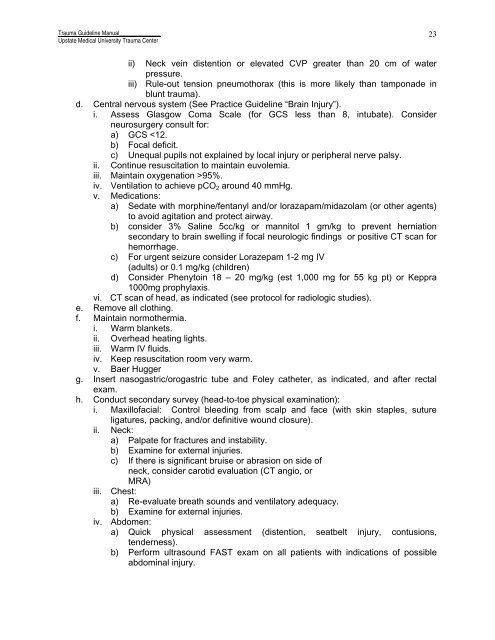Trauma Guideline Manual - SUNY Upstate Medical University
Trauma Guideline Manual - SUNY Upstate Medical University
Trauma Guideline Manual - SUNY Upstate Medical University
You also want an ePaper? Increase the reach of your titles
YUMPU automatically turns print PDFs into web optimized ePapers that Google loves.
<strong>Trauma</strong> <strong>Guideline</strong> <strong>Manual</strong>______________<strong>Upstate</strong> <strong>Medical</strong> <strong>University</strong> <strong>Trauma</strong> Center23ii) Neck vein distention or elevated CVP greater than 20 cm of waterpressure.iii) Rule-out tension pneumothorax (this is more likely than tamponade inblunt trauma).d. Central nervous system (See Practice <strong>Guideline</strong> “Brain Injury”).i. Assess Glasgow Coma Scale (for GCS less than 8, intubate). Considerneurosurgery consult for:a) GCS 95%.iv. Ventilation to achieve pCO 2 around 40 mmHg.v. Medications:a) Sedate with morphine/fentanyl and/or lorazapam/midazolam (or other agents)to avoid agitation and protect airway.b) consider 3% Saline 5cc/kg or mannitol 1 gm/kg to prevent herniationsecondary to brain swelling if focal neurologic findings or positive CT scan forhemorrhage.c) For urgent seizure consider Lorazepam 1-2 mg IV(adults) or 0.1 mg/kg (children)d) Consider Phenytoin 18 – 20 mg/kg (est 1,000 mg for 55 kg pt) or Keppra1000mg prophylaxis.vi. CT scan of head, as indicated (see protocol for radiologic studies).e. Remove all clothing.f. Maintain normothermia.i. Warm blankets.ii. Overhead heating lights.iii. Warm IV fluids.iv. Keep resuscitation room very warm.v. Baer Huggerg. Insert nasogastric/orogastric tube and Foley catheter, as indicated, and after rectalexam.h. Conduct secondary survey (head-to-toe physical examination):i. Maxillofacial: Control bleeding from scalp and face (with skin staples, sutureligatures, packing, and/or definitive wound closure).ii.Neck:a) Palpate for fractures and instability.b) Examine for external injuries.c) If there is significant bruise or abrasion on side ofneck, consider carotid evaluation (CT angio, orMRA)iii. Chest:a) Re-evaluate breath sounds and ventilatory adequacy.b) Examine for external injuries.iv. Abdomen:a) Quick physical assessment (distention, seatbelt injury, contusions,tenderness).b) Perform ultrasound FAST exam on all patients with indications of possibleabdominal injury.
















